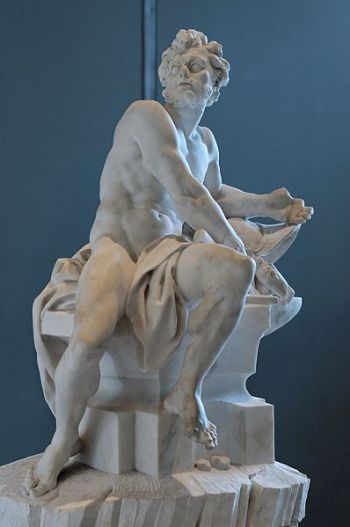Ancient robots
Most probably there were no ancient robots in the antiquity. At least not in the way we understand it. Nevertheless, there is considerable amount of myths and tales that talk about artificial, yet “living”, beings. Also, there is evidence that devices with some level of automation existed throughout the antique world.
The main idea these facts point to is that people have always been interested in creating “living” things. It is the same interest and curiosity that drives us today. While there are robots that are designed to use them practically, there are also many that are made just to show that it can be done.
Myths featuring ancient robots

A man in this sculpture is a Greek god called Hephaestus. He was regarded as the god of technology, blacksmiths, craftsmen and artisans. Amongst many of his marvelous creations, myths also feature various artificial beings.
It is said that Hephaestus made ancient robots to help him in his workshop. Greek mythology also states that a bronze giant called Talos was made by Hephaestus as well. This bronze giant would patrol around the island and throw rocks at enemy ships.
A roman counterpart of Hephaestus is called Vulcan. Vulcan was also regarded as the god of craftsmen and technology. The roman mythology states that Vulcan made slave-girls of gold for himself.
Also there are ancient stories of Chinese origin that features ancient robots. Usually these stories suggest that told events actually took place at some time in past in the real world. Creations vary by their application but they all are stated to be created artificially. Also their possibilities are quite stunning – dancing, singing, recognition of environment.
The most famous Chinese story of this kind can be found in Lie Zi text. The text itself is written in 3rd century BC but the tale takes place in 10th century BC. The story is about an encounter between an artificer called Yan Shi and a king Mu of Zhou.
It is said that Yan Shi demonstrated an artificial man to the king. The man could walk, sing and dance and it was indistinguishable from a real human. Moreover, it is said that it had bones and realistic organs that functioned the way Chinese traditional medicine suggests a human body functions.
Whether there are some bits of truth in these stories we can’t tell for sure. Supposedly, these stories are fiction. In either case, stories like that demonstrate our fascination about artificially made beings that was with us also in antiquity.
Real ancient robots
Again, by saying ancient robots I am stretching a definition of a robot. Maybe it would be more correct to call them ancient automated devices or something like that. Either way you probably know what I mean.
Yes there were real automated devices in the antiquity. At that time those would be treated like something magic or supernatural. And that is the most common way how they supposedly were used. It seems that ancient Greeks used that kind of devices in temples to impress people and in theatres for amusement.
Of course, there weren’t any electronics or stuff like that incolved. Ancient people used mechanical principles they already knew about. To get a grasp on the idea you can watch a video by New Scientist where they demonstrate a recreated programmable cart that was designed by Heron of Alexandria.
As you can see, this is a real AGV (automated guided vehicle). It is automated because you can program it to move in the pattern you like. Of course, it does not respond to the environment, but the idea is still pretty ingenious. If a different automaton, that can move its arms and that wears a long dress, is stacked upon this cart, you get a robot that dances.
Whether you believe in ancient myths about very advanced artificial beings or not is your choice. However,what we know for sure is that there were automated puppets and stuff like that in the antiquity. On the other hand, it is impossible to know for sure the magnitude at which these devices were used. It is possible that they were more common than we think.
In either case, the myths about artificial beings that ancient people wrote, as well as the existence of actual ancient robots points in one direction. These facts point out our interest in creating artificial life that still drives us today.
